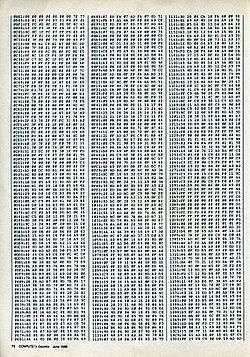MLX (software)
MLX is a series of machine language entry utilities published by COMPUTE! Publications for COMPUTE!, COMPUTE!'s Gazette, and various books. These programs were designed to allow relatively easy entry of the type-in machine language listings that were often included in these publications. Versions were available for the Commodore 64, PET and VIC 20, the Atari 8-bit family and the Apple II series.
First version
MLX was first introduced in the December 1983 issue of Compute!, with versions for both the Commodore 64 and Atari 8-bit family.[1] This was followed the next month by a version for the VIC-20 ("Tiny MLX") that was otherwise similar.
These versions of MLX shared a format consisting of six data bytes in decimal format, plus a seventh byte which served as a checksum. Although each line began with the memory address, and bytes were separated with commas, these did not have to be typed; the program auto-incremented the address and automatically printed the comma delimiters every three characters. Invalid keystrokes were filtered out. When a line was completely typed, it was automatically verified against the checksum value. If it matched, the user would be prompted for the next line. If not, a warning buzzer would sound and the invalid input would be discarded so that the user could retype the line. Several keyboard keys were redefined to create a makeshift numeric keypad.
Generally, MLX listings were reserved for relatively long machine language programs such as SpeedScript, while shorter programs were often printed in the form of BASIC loaders that used DATA statements to POKE the code into memory.

Although the original MLX was a more efficient entry method than BASIC loaders with DATA statements, it had a number of issues. Foremost among them was that it POKEd the data entered directly into the affected area of memory. Since many machine language programs were located partially or entirely in the BASIC RAM area, this meant that the user had to manually adjust the pointers to the top and bottom of BASIC RAM (using POKE statements provided in the article) before running MLX to keep the entry program from encroaching on the code and vice versa. If a program was entered in multiple sittings, this had to be done each time. Also, decimal storage required seven keystrokes for each two bytes entered (taking into account the checksums). Furthermore, many transposition errors were overlooked by the original MLX's unsophisticated checksum algorithm.
Improved version
A new version of MLX was introduced for the Apple II family in the June 1985 issue.[2] This version used an 8-byte-per-line hexadecimal format. A more sophisticated hash algorithm was implemented to catch errors overlooked by the original, only failing to notice a substitution of 0xFF and 0x00.
The same improved layout and hashing was then backported to the Commodore 64. This version also added an editor buffer located at a single location in memory, removing the need to POKE memory locations at startup. The new version, known simply as "the new MLX", first appeared in the December 1985 issue of COMPUTE!.[3] It appeared in COMPUTE!'s Gazette the following month. This replacement version of MLX was very successful, and continued to be used until COMPUTE!'s Gazette switched over to a disk-only format in December 1993.
Sources
References
- ↑ Charles Brannon, "MLX: Machine Language Entry Program For Atari And Commodore 64", COMPUTE!, December 1983, p. 216
- ↑ Tim Victor, "Apple MLX: Machine Language Entry Program", Compute!, June 1985, p. 114
- ↑ Ottis Cowper, "The New MLX: Enhanced Machine Language Editor for the Commodore 64", Computer!, December 1985, p. 74
